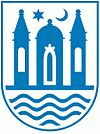Svendborg Municipality (Svendborg Kommune)
 |
South of the municipality separating that part located on Funen from the other islands is Svendborg Strait (Svendborg Sund).
The 1,220-meter (4003-ft) long Svendborgsund Bridge (Svendborgsundbroen) connects the municipality at the city of Svendborg over the islands of Tåsinge and Siø, where the 774 meter (2540 ft) long Langeland Bridge (Langelandsbroen) continues to the city of Rudkøbing on the island of Langeland. The Svendborgsund Bridge was opened in 1966. The Langeland's Bridge was opened in 1962, and is Denmark's 10th longest bridge.
Ferry service connects the municipality at the town of Svendborg to the municipality's islands of Skarø, Drejø, and Hjortø, and to the town of Ærøskøbing on the island of Ærø.
On 1 January 2007 Svendborg municipality was, as the result of Kommunalreformen ("The Municipal Reform" of 2007), merged with Gudme and Egebjerg municipalities to form an enlarged Svendborg municipality.
Svendborg's municipal council consists of 29 members, elected every four years. The municipal council has seven political committees.
Map - Svendborg Municipality (Svendborg Kommune)
Map
Country - Denmark
 |
 |
| Flag of Denmark | |
As of 2013, the Kingdom of Denmark, including the Faroe Islands and Greenland, has a total of 1,419 islands above 100 m2; 443 of which have been named and of which 78 are inhabited. Spanning a total area of 42943 km2, metropolitan Denmark consists of the northern part of the Jutland peninsula and an archipelago of 406 islands. Of these, the most populated island is Zealand, on which the capital Copenhagen is situated, followed by Funen, the North Jutlandic Island, and Amager. Denmark's geography is characterised by flat, arable land, sandy coasts, low elevation, and a temperate climate. As of 2022, it had a population of 5.928 million (1 October 2022), of which 800,000 live in the capital and largest city, Copenhagen. Denmark exercises hegemonic influence in the Danish Realm, devolving powers to handle internal affairs. Home rule was established in the Faroe Islands in 1948 and in Greenland in 1979; the latter obtained further autonomy in 2009.
Currency / Language
| ISO | Currency | Symbol | Significant figures |
|---|---|---|---|
| DKK | Danish krone | kr | 2 |
| ISO | Language |
|---|---|
| DA | Danish language |
| EN | English language |
| FO | Faroese language |
| DE | German language |















